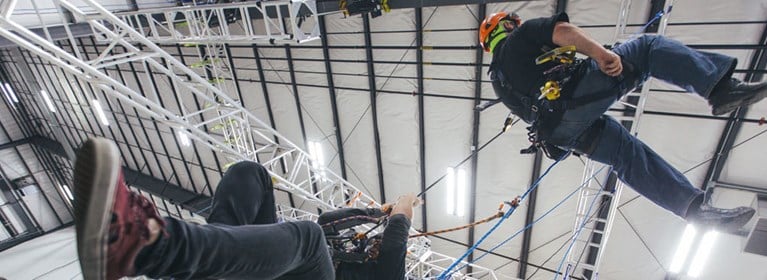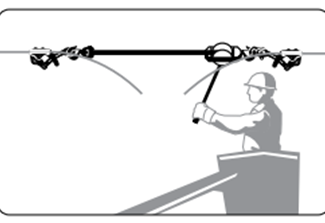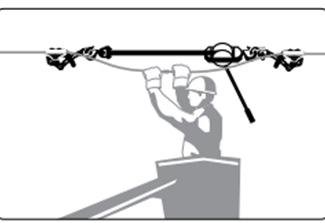
How to Safely Splice and Dead-End Wires in Utility Applications
Power and Utilities | Rigging | How To's | Safety and Training | By Christie Lagowski | Jan 11, 2018
Whether dead-ending or splicing lines, safety is of utmost importance. To ensure you are using products correctly while performing these activities, we suggest following the procedures below:
Figure 1

Dead-Ending Wire
- To begin, arrange your ratchet lever hoist and wire grip as shown in Figure 1. Use shackle connections where necessary.
- Tension the strap hoist until the cable is aligned with the cable’s ending point.
- After reaching the appropriate level of tension, tighten the strap a bit more to account for a loss of tension after the hoist is removed. Be sure to reference technical information to ensure the cable is not tensioned tighter than recommended by the manufacturer.
- To complete the dead-ending, alleviate the tension using the lever hoist handle. A drum knob can also be used to fully release the tension.
Figure 2

Figure 3

Splicing Wire
- To begin, arrange the ratchet lever hoist and wire grips as shown in Figures 2 and 3. Use shackle connections where necessary.
- Attach the ratchet lever hoist to each wire grip. Tension the strap hoist until you reach the desired tension before splicing. Once you reach this tension, splice the wire in line with your company’s procedures and guidelines.
- To complete the job, alleviate the tension using the lever hoist handle. A drum knob can also be used to fully release the tension.
Columbus McKinnon offers a large selection of hoists and rigging products designed for utility transportation and distribution applications. Learn more.
Need help choosing the right wire grip for your application? See our blog article.
Disclaimer:
This article is not intended to be a detailed instructional manual for performing these procedures. Always consult your company or industry procedures, as well as the manuals for the equipment, including, without limitation, the equipment manufacturer’s guidelines, prior to performing these procedures. Columbus McKinnon Corporation disclaims any liability, in tort, contract or otherwise, for any loss or damage arising from use of the information in this article, including but not limited to indirect or consequential damages, lost profits or goodwill, or punitive damages.
Explore Our Utility Product Solutions
Whether repairing overhead power lines after a storm or performing routine maintenance on an electric power distribution system, Columbus McKinnon hoists and rigging products can help. With nearly 150 years of industry experience and well-known brands such as Little Mule® and Coffing® Hoists, we offer a large selection of products developed specifically for the needs of the utility industry.

Related Articles
How to Inspect Your Lever Strap Hoist
Featuring the Little Mule 344C Lineman's Strap Hoist
When it comes to lever hoists, utility professionals rely on a variety of different hoists to get the job done.
How to Clean, Lubricate and Inspect Your Wire Grips
A Guide to Maintaining Wire Grips & Ensuring Safety in Utility Applications
To keep your wire grips in good working condition, it's important that you properly clean, lubricate and inspect your wire grips on a regular basis.

 North America - EN
North America - EN

